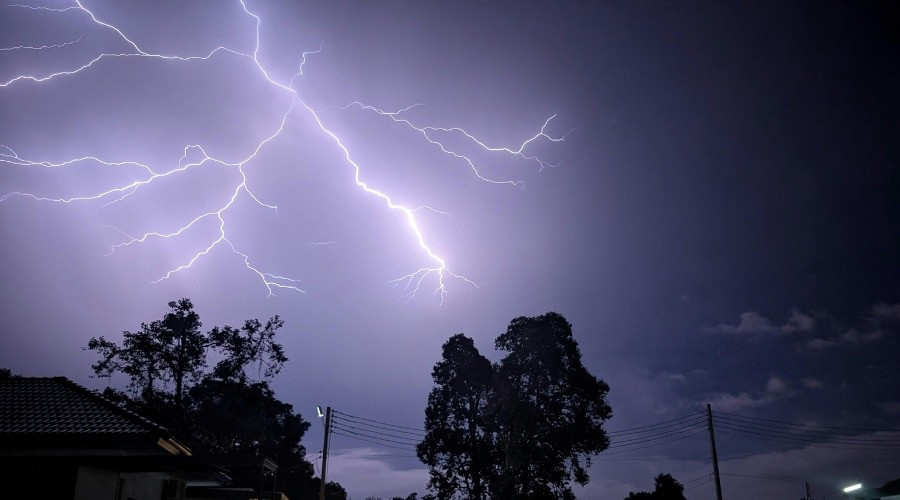Power Surges and Whole Home Surge Protectors Explained
Effective surge protection is the first line of defense against damaging power surges. A single spike can disable sensitive electronics and appliances in seconds, turning a routine day into a costly headache. With the right plan, an entire electrical system can be shielded from unexpected voltage events. This overview covers common surge risks, the advantages of a whole-home surge protector compared with a power strip surge protector, and how to recognize when existing equipment is due for replacement. It also highlights the value of proper surge protector installation for reliable, long-term protection.
Dangers of Power Surges
 Lightning activity, utility switching, and wiring faults can trigger a power surge that moves through outlets and hardwired circuits in an instant. Internal sources are common as well—large appliances cycling on and off can create smaller spikes that repeatedly stress connected devices. Even brief surges can push excess voltage into microprocessor-based equipment such as smart TVs, gaming systems, routers, and modern kitchen appliances.
Lightning activity, utility switching, and wiring faults can trigger a power surge that moves through outlets and hardwired circuits in an instant. Internal sources are common as well—large appliances cycling on and off can create smaller spikes that repeatedly stress connected devices. Even brief surges can push excess voltage into microprocessor-based equipment such as smart TVs, gaming systems, routers, and modern kitchen appliances.
The immediate impact may include flickering screens, unexpected shutdowns, or devices that fail to restart. Repeated minor spikes are just as concerning because they gradually weaken circuit boards and power supplies, shortening service life without obvious warning. In some cases, overheated components or damaged insulation can elevate fire risk at receptacles or within walls. Because many events leave little trace, the threat is often underestimated. Establishing layered surge protection—starting with a whole house surge protector at the panel and complementing it with selective point-of-use devices—helps divert excess energy and reduce the chance of hidden damage building up over time.
Benefits of Installing a Whole House Surge Protector
 A whole house surge protector, also called a whole-home surge protector, is installed at the main electrical panel to intercept damaging voltage before it spreads across branch circuits. Unlike a power strip surge protector that safeguards only the items plugged into it, panel-level protection helps shield every circuit at once—outlets, lighting, and hardwired equipment like HVAC systems, refrigerators, well pumps, and ovens. This comprehensive approach addresses the entire home rather than a single room.
A whole house surge protector, also called a whole-home surge protector, is installed at the main electrical panel to intercept damaging voltage before it spreads across branch circuits. Unlike a power strip surge protector that safeguards only the items plugged into it, panel-level protection helps shield every circuit at once—outlets, lighting, and hardwired equipment like HVAC systems, refrigerators, well pumps, and ovens. This comprehensive approach addresses the entire home rather than a single room.
Layered protection offers the best results. The panel-mounted device handles the bulk of surge energy, while point-of-use strips provide added defense for delicate electronics. Professional surge protector installation ensures correct connection, grounding, and bonding so excess voltage can be safely diverted away from the home’s wiring. With proper setup, a whole home surge protector reduces the likelihood of widespread equipment failure during storms and utility disturbances, supports uptime for critical appliances, and can help avoid costly replacements. For properties that rely on smart devices and connected systems, this broader shield is a practical upgrade beyond basic plug-in strips.
Signs to Replace an Old Surge Protector
Surge protection equipment does not last indefinitely. Each power surge absorbed can wear internal components, gradually reducing effectiveness over time. Several indicators suggest it is time for replacement. Status lights that no longer show “protected,” unusual buzzing or heat at the unit, and any signs of scorching, discoloration, or cracked housing near the device are strong warnings. Circuit breakers that trip repeatedly after storms or connected electronics that start behaving erratically may also point to declining protection.
Even when no obvious damage is visible, aging devices and frequent power surges warrant a closer look. Power strip surge protectors can wear out as well; dim or failed indicator LEDs and persistent warmth are cues to replace them. Periodic evaluation by a qualified electrician can confirm whether the whole-house surge protector is still performing as intended and whether new surge protector installation would restore full coverage. Keeping protection current—both at the panel and at sensitive equipment—helps ensure the next power surge is diverted safely rather than traveling into valuable appliances and electronics.
About Hunter Service Group
Hunter Service Group is a trusted, locally owned and operated HVAC and electrical company offering expert service from trustworthy, hardworking techs. Call them today to schedule whole house surge protector services in San Antonio, TX.




